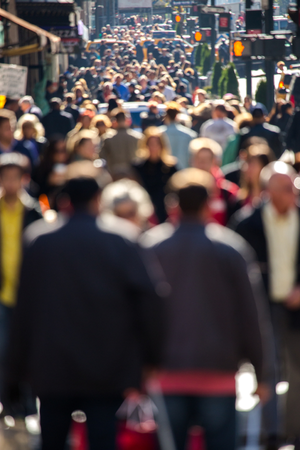Anticipation is the Key to Crowd Physics
Accurately predicting the flow of pedestrian crowds can help architects and planners of outdoor events, but researchers have had trouble modeling them in a simple way. By analyzing large databases of real crowds, a team has now revealed a simple and general rule of interaction based on a pedestrian’s ability to predict trajectories and avoid collisions with others. This rule led the researchers to realistic simulations of crowd patterns and might help planners predict dangerous congestion at sporting events, festivals, and other public gatherings.
In 2010 extreme overcrowding at the Love Parade festival in Germany caused the deaths of 21 people and injured more than 500. With an accurate model for crowd flow, Stephen Guy of the University of Minnesota in Minneapolis believes that similar tragedies in the future could be prevented. A realistic model could also help programmers make crowd scenes in video games, virtual reality simulations, and films look more lifelike. “Looking further into the future,” says Guy, “imagine a stadium automatically texting you the best exit to leave from to avoid the crowds.” But determining an accurate and general rule for pedestrian interactions has challenged researchers.
Early crowd simulations assumed that humans behave as a collection of repulsive particles, and the inter-particle force depends on distance [1]. But these simulations failed to replicate known crowd dynamics, such as the tendency of people traveling in the same direction through a crowded park or hallway to walk close together.
Two years ago researchers showed that pedestrians in a lab setting change course only if they predict walking within a meter of one another; otherwise, they maintain their current directions [2]. This result suggests that pedestrians’ ability to anticipate future collisions could be the key factor in much larger crowd dynamics, says Guy.
To investigate this “anticipation force” in large crowds, Guy and his colleagues assembled a video database of real crowd interactions. The two settings they analyzed were a sparse crowd of people in an outdoor space, including students milling around in an open area on a university campus, and a dense crowd passing through a bottleneck doorway. The researchers measured the separation between each pair of people in the videos in two ways: the distance between the pair and the time until a future collision, assuming the pair did not change course. For each video frame, they counted the number of pairs–essentially the probability—for each separation distance and for each time-to-collision.
Looking at the separation distance, the probability plot was very different for different walking speeds—slow walkers were much more likely to cluster together than were faster walkers. But the probabilities for times-to-collision were the same for all speeds, meaning that fast walkers on a collision course avoided each other long before slow walkers did. In addition, regardless of speed, the time-to-collision measure accounts for pedestrians coming relatively close to one another when moving in roughly the same direction, whereas those walking toward each other keep more distance.
Based on the data, the researchers came up with a simple mathematical law for the “repulsive force” between two pedestrians—similar to the force law between electrons but based on their time-to-collision, rather than their separation distance. With this law they created computer simulations for a variety of urban settings and saw familiar crowd features emerge. For example, in an open space with a large crowd composed of people walking toward multiple destinations, one-way “lanes” of pedestrians formed spontaneously, a phenomenon that was difficult to obtain with previous simulations.
The team’s results suggest that crowds can be universally parameterized by a single variable based on pedestrians’ predictions, says Guy. “Unlike, say, electrons, humans have a brain and can think through the consequences of our actions.” He envisions crowd models that can foresee potential dangers in buildings and public spaces well before any construction takes place.
“This work stands out among other papers in the field of collective motion,” says Igor Aronson of Argonne National Laboratory in Illinois. “The authors convincingly demonstrate that human interactions in crowds can be cast in a surprisingly simple form if they are computed as a function of time-to-collision.”
This research is published in Physical Review Letters.
–Tamela Maciel
Tamela Maciel is a freelance science writer in Leicester, UK.
References
- Dirk Helbing, Illés Farkas, and Tamás Vicsek, “Simulating Dynamical Features of Escape Panic,” Nature 407, 487 (2000)
- Anne-Hélène Olivier, Antoine Marin, Armel Crétual, and Julien Pettré, “Minimal Predicted Distance: A Common Metric for Collision Avoidance During Pairwise Interactions between Walkers,” Gait & Posture 36, 399 (2012)





